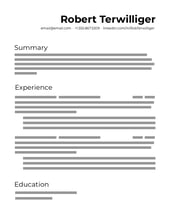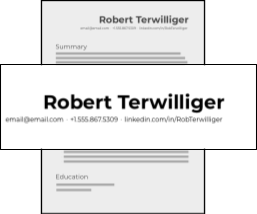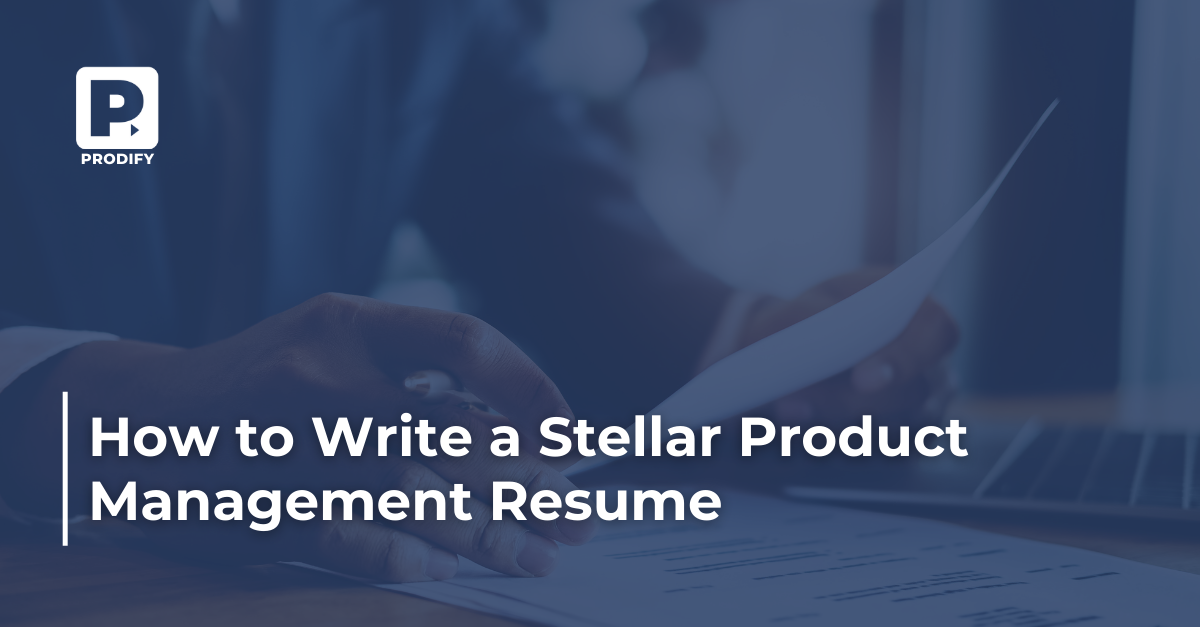In our collective careers, the Prodify advisors have reviewed thousands of product manager resumes. Sadly, for both the candidates and the managers reviewing them, the vast majority of these resumes aren’t that great. Sure, some of these are from people reaching by applying for a job just outside of their experience. But, too many of them are from PMs whose experience should present well in resume form but whose resumes miss the point entirely.
Before I go any further, I want to provide a disclaimer that this advice is based on my—and other Prodify advisors—preferences, pet peeves, and idiosyncrasies. Your mileage may vary. Side effects may include a new job. Etc.
Purpose of Your Resume
To make sure we’re all on the same page, let’s first define a resume’s purpose. Regardless of role, a resume has two primary purposes.
First, and most commonly, it is a way to get an interview. I only say ‘a way’ because so many interviews are not gotten because of blindly sent resumes, but rather because of networking and referrals. That’s a whole other topic, but let’s just stipulate that a resume’s primary purpose is to get an interview.
The second—and less appreciated—role your resume plays once you get your “foot in the door” is to give an employer a reason not to hire you. That’s right; your carefully crafted resume can now be weaponized to prevent you from getting the job. Your resume is used during the interview and referral process. Expect there to be questions on the details you put down. Interviewers will likely ask what your role was within the projects you list, so they can understand what you specifically did to drive the outcome. Same question may come up during referrals. So, be sure that you can speak confidently to your role for everything you list.
The Actual File
I printed my first resume on 100% cotton, 24lb, ivory resume paper. I sent it through the actual mail to employers that I found in the print Help Wanted section of The Washington Post. I still read advice saying that job seekers should have fancy printed versions of their resume ready to hand out at an interview. That may be true in some industries, but for tech roles, I think that advice is as good as telling people to scour the print Help Wanted ads of The Washington Post.
Instead of worrying about the physical resume, your job is to concern yourself with the digital version. And I’m going to make your decisions easy for you.
What design should I use?
Use our free template and spend all your time focusing on the content. There are fancier resume templates out there with graphics and bold colors. I’m okay with those for design roles, but I want the content to be what shines through for a PM role. Thus, our PM resume template is attractive but hopefully will always be substance over style.
What should I name the file?
Name your resume file only your first and last name. If you want to get fancy, you can include the word ‘resume’ in the filename, but please don’t include anything else. Just keep it simple.
What file format should I use?
PDF. Don’t send a Word file. I haven’t had MS Word on my computer since 2008. If I open up your resume with Pages or Google Docs, it will not look the way you intended.
Resume 101

Before I get into advice for each section, and in case you start to skim the rest, I need to impart the most important advice I can give. Scrub your resume for typos. As I’ve gotten older, I’ll forgive a single typo, but it pains me to do it. I'm always looking for detail-oriented PMs, and typos on a 1-2 page document does not exemplify the level of detail many managers expect.
And now, on to the sections. A traditional resume has four primary sections: header, summary, experience, and education. Although other sections can be useful, busy hiring managers are mostly looking for these four sections.
Header
Think of your header as your business card and as that handy little tab on the top of file folders. It needs to give the hiring manager the tools to reach out to you and help her find your resume in a stack populated by your competition.
- For U.S.-based roles, only include your name, email address, phone number, and LinkedIn profile.

- Don’t include your home address or a photo. Unfortunately, these can be used to discriminate against you. And since they add no value to helping a hiring manager get in touch with you —there is no benefit to including them.
- Make your name the most prominent feature so a hiring manager can find it easily when shuffling through multiple windows or printouts.
- If the role you’re applying for values international experience, include your country code (+1 in the U.S.) to let employers know that you don’t think the U.S. is the center of the universe.
- Unless another social network is relevant for the role (e.g., applying for a position at Facebook), only include your LinkedIn on your resume. If you haven't already, you should customize your public URL with something friendly (and professional).
Summary
.png?width=257&name=PM%20resume%20blog%20post%20(1).png)
Sadly the summary has become the area to stuff with keywords for applicant tracking systems. I wish we lived in a world where this wasn’t true, but for larger organizations, Skynet is currently winning, so treat your computer gatekeepers well, and they will pass you on to a human. If you’re applying to a startup, likely a hiring manager will still review your resume the old fashioned way. So, I like a balance of keyword density that is human readable.
- Tell a quick (keyword dense) story about yourself. Think of it as your (keyword dense) elevator pitch.
- If you have a personality, this is the time to lead with it. But keep it professional.
- Don’t write in the third-person. Every hiring manager knows that you wrote it, so just use the first-person. Matte would never use the third person when talking about himself, and neither should you.
- Don’t include an Objective section instead of your Summary. Writing “My objective is to obtain a challenging career that best utilizes my skill set” is nonsense that doesn’t help say anything about you and what you’ve done. If you’re just starting in your professional career, talk about your academic and volunteer experiences.
Experience
Everything that came before was just prologue. You can’t ignore those sections, but this is where you should spend the bulk of your time. Your experience section should include both the position held and outcomes achieved for every role you’ve had.
Position held
Let your positions tell a scannable story about your responsibilities. Imagine a hiring manager just skimming all your roles in reverse chronological order. I’m not saying we do that, but we do. We’re busy, and that’s one of the first pieces of data we generally read on a resume. Skimming your roles is your resume’s ELI5.
This should read like, “I held this role/title at this company/department for this time period.”
Role/titles
Some people use formal titles (e.g., Sr. Product Manager L4) on their resumes, while others prefer to use their roles (e.g., Head of Data Product Management). Which you use is a point of personal preference.
Either way, make sure your title or role will stand up to background and reference checks. Titles are an area where some people stretch the truth, and it bites them in the behind later on. If you choose to use titles and your company uses insane titles like PM L4, add a human-readable alternative parenthetically: Product Manager L4 (Sr. PM)..png?width=300&name=PM%20resume%20blog%20post%20(2).png)
Company/department
Hiring managers are especially interested in the company names. We’re looking for companies relevant for the role or those with a solid track record of having strong PMs. If you work for a mega-corp that’s a household name, please include the department as well. Being a PM for Apple is one thing, but being a PM for Apple Photos tells a story.
Some people still insist on including the location for each position. For most resumes, this ends up being just noise. However, if you have international experience (demonstrating your global mindset) or have a track record of moving for jobs (demonstrating your willingness to relocate for the right role) you may choose to include locations as well..
The other important thing to include is a few sentences to familiarize the hiring manager with the company or department. Don’t expect a hiring manager to research each company for which you’ve worked. Sadly, many managers may just pass on your resume if there is a string of companies with which they are unfamiliar.
Time period
I recommend going with a simple Month Year - Month Year format. Going any more granular or broader doesn’t add anything to the hiring manager’s ability to understand your career journey. If you’ve had multiple roles at the same company, include your overall duration with the company and the individual duration for each position. To help, we’ve included this specific case on the resume template.
Outcomes achieved
Limit your bullets to five if possible, and focus on outcomes you've achieved. Also, avoid including generic work descriptions (e.g., ran thrice-weekly standups and curated the backlog) as a PM's calling card should be focused on outcomes, not work effort..png?width=240&name=PM%20resume%20blog%20post%20(3).png)
These bullets should read: “Had a specific and valuable impact for our customers or business by doing something.”
We’ve included a bunch of examples on the resume template, but they should look something like:
“Increase retention by 40% for our small-business customers by releasing a five-star rated iOS App that allowed them to….”
And as I mentioned in the introduction: be truthful, don’t exaggerate, don’t include confidential information.
On that note, anytime you include metrics, discuss relative performance whenever possible as opposed to absolute performance. So instead of “increased retention from 10% to 14%,” say “increased retention by 40%.” In the first case, you’re (intentionally or not) leaking potentially confidential information.
Education
Some companies care a ton about your educational pedigree, some not at all. I tend to only pay attention to it if you graduated from a program of particular interest. Otherwise, I don’t use it against a candidate. However, I’m not the only hiring manager in the world, and many do not agree with me.
This section should read: “Degree from institution-name.”
I only advise including dates if they are in the future (e.g., expected graduation
.png?width=240&name=PM%20resume%20blog%20post%20(4).png)
May 2025). Otherwise, the date on the resume can only be used to discriminate against you. Once you get the interview, you may be asked about your graduation date, but as your resume is trying to get you that interview, don’t give them any excuses to pass on you.
If you don’t have a post-high school education, I’d remove this section entirely. Let your experience speak for you, and if a hiring manager is too myopic to value that experience, the role is probably not the best fit for you anyhow.
Closing Thoughts
We hope this guide and our resume template help you find your next role. Drop us a line at hello@prodify.group to let us know what was helpful and what advice you ignored. Also, reach out if your new employer needs product advisory, training, hiring, or coaching services. We’re happy to help.



.png?width=257&name=PM%20resume%20blog%20post%20(1).png)
.png?width=300&name=PM%20resume%20blog%20post%20(2).png)
.png?width=240&name=PM%20resume%20blog%20post%20(3).png)
.png?width=240&name=PM%20resume%20blog%20post%20(4).png)